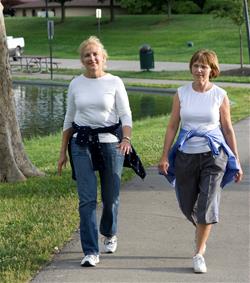Promoting Physical Activity

Cardiovascular nurses are seasoned professionals at promoting physical activity to their patients. But the way our communities are designed can create barriers that make physical activity more difficult for some. Fortunately, there are a number of initiatives that address these barriers to promoting physical activity.
National Physical Activity Plan
The National Coalition for Promoting Physical Activity’s recently released National Physical Activity Plan1 emphasizes the important relationship between the nature of the built environment and whether people perform physical activity. They suggest changes in transportation, land use, and community design in an effort to reduce sedentariness and promote movement and active behaviors. For thoroughfares and intersections to be more user-friendly for physical activity, preventive cardiovascular nurses in general and PCNA advocates can work with community groups to:
- Invest in bicycle and pedestrian infrastructure and transit
- Change neighborhood plans so people have places to walk or bike to
- Advocate for funding and policies that increase active transportation and physical activity
- Invest in and institutionalize the collection of data to inform policy and measure the impact of active transportation on physical activity.
Complete Streets
Depending on where your patients live, they might be able to take advantage of the Complete Streets initiative1 now underway in many cities and towns across America. What is Complete Streets? The idea is that streets are for everyone. The emphasis is on safe access to encourage active transportation for walkers, cyclists, and those needing safe paths and areas near public transportation (bus and train stations).
Since 2004, this national non-profit coalition, run by public interest organizations and transportation professionals, has been committed to implementing Complete Streets practices in regard to transportation networks. Complete Streets focuses on the redesign of current roads, as well as plans for future road projects. In the short term, its mission is safe access for all road users regardless of ability, age, or mode of transportation. In the long term, a selling point is that it will make cities and towns better places to live.
Preventive cardiovascular nurses can become active in their local community groups or work with patients to start an initiative locally. This initiative is as another way to promote physical activity to reduce cardiovascular risk factors at the population level. To assist, the initiative’s website provides the Best Community Street Projects chosen annually, fact sheets, case studies, webinars, and reports of successful street designs.
Each Complete Street design has a different look, but the changes all follow a theme of increasing physical activity and, at the same time, reducing transportation woes and traffic costs. Examples of strategies are bike lanes or wide paved shoulders, special bus lanes, sidewalks, frequent and safe crossing opportunities, median islands, accessible pedestrian signals, narrower travel lanes, accessible public transportation stops, curb extensions, and roundabouts. You might have noticed that some of these changes are already occurring in your community.
Sharing the Road
Since 2016, the Sharing the Road initiative,3 through a consortium of state judges and national highway authorities, has focused on the interface between drivers and cyclists on our roads. One major solution was to pass laws for drivers to keep a safe distance (3 feet) when passing a cyclist, giving them room when overtaking them. These laws, as well as share the road signs that you might have seen in your community, promote safety so that exercisers can gain positive health benefits from active transportation.4
References
- National Coalition for Promoting Physical Activity. National Physical Activity Plan. http://ncppa.org/national-physical-activity-plan. Retrieved January 2019.
- Smart Growth America-Improving lives by improving communities. What are Complete Streets? https://smartgrowthamerica.org/program/national-complete-streets-coalition/publications/what-are-complete-streets. Retrieved January 2019.
- National Center for State Courts and the National Highway Traffic Safety Administration. Traffic Resource Center for Judges. http://home.trafficresourcecenter. org/~/media/Microsites/Files/traffic-safety/SharingtheRoad.ashx. Retrieved January 2019.
- Mueller N, Rojas-Rueda D, Cole-Hunter T, de Nazelle A, Dons E, Gerike R… Nieuwenhuijsen M. (2015). Health impact assessment of active transportation: A systematic review. Preventive Medicine, 76, 103-114. doi: 10.1016/j.ypmed. 2015.04.010.
